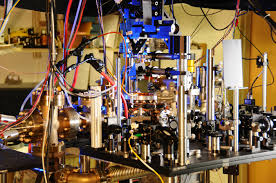Optical Atomic Clock

- 13 Jul 2025
In News:
In a landmark advancement, an international team of 65 scientists from six countries conducted the world’s largest and most accurate optical atomic clock comparison across three continents. This is a major step towards redefining the SI unit of time — the second — using optical atomic clocks instead of current caesium-based clocks.
Current Definition of a Second
- Defined since 1967 by the International System of Units (SI):
One second is the time it takes for 9,192,631,770 cycles of microwave radiation emitted during the transition between two hyperfine levels of the ground state of a caesium-133 atom.
- In India, the National Physical Laboratory (NPL) in New Delhi maintains the time standard using five caesium atomic clocks, disseminating the output via INSAT satellites, telecom signals, and fibre links.
Why Redefine the Second?
Limitations of Caesium Clocks:
- Frequency: 9.19 billion Hz (microwave range).
- Stability: Drifts by 1 second every 300 million years.
- Insufficient for the growing precision demands of:
- Global Positioning Systems (GPS, NavIC, Galileo)
- Climate science (e.g., measuring gravity changes due to ice loss)
- Radio astronomy (e.g., black hole imaging)
- Quantum technologies and space navigation
Optical Atomic Clocks: The Next Time Standard
Advanced atomic clocks that use visible light (optical frequencies) rather than microwaves to measure atomic transitions, allowing much higher precision.
Atoms Used:
- Strontium-87 (Sr)
- Ytterbium-171 (Yb)
- Charged Ytterbium Ions (Yb? E2, Yb? E3)
- Charged Strontium-88 (Sr?)
- Indium-115 ions (In?)
Working Principle:
- Atoms are held in optical lattices or ion traps.
- A laser, tuned to the atom’s natural frequency, stimulates atomic transitions.
- The resulting oscillations — which occur hundreds of trillions of times per second — are counted to define one second.
Superior Attributes:
- Frequency range:
- Strontium: 429 trillion Hz
- Ytterbium: 642 trillion Hz (≈ 10,000 times greater than caesium clocks)
- Unmatched stability: Drift of 1 second in 15 billion years in some cases
- Precision: Agreement between clocks within 10?¹? to 10?¹?, enabling ultra-precise synchronization globally
The Global Clock Comparison: Key Highlights
Objective:
To test whether optical clocks across the world remain synchronized at ultra-high precision, a prerequisite for redefining the SI second.
Experiment Overview:
- Duration: 45 days (Feb 20 – Apr 6, 2022)
- Participants: 10 optical clocks across six countries (Germany, France, Italy, Japan, Finland, UK)
- Atoms used: Sr, Yb, Sr?, Yb? (E2 & E3), In?
- Techniques:
- Optical fibre links between countries
- Advanced GPS method: Integer Precise Point Positioning (IPPP)
- Backups: GPS-based clocks during maintenance downtime
Key Outcomes:
- 38 independent frequency ratios measured — most extensive comparison to date
- 4 new ratios measured for the first time, including:
- Yb?(E3) to Yb
- In? to Yb
- Sr? to Sr
- Sr? to Yb
- Precision Achievements:
- Sr clocks in Germany and France: differed by < 2 × 10?¹?
- In? and Yb?(E3) clocks in Germany: matched within 4.4 × 10?¹?
- Germany–UK clocks: matched within 3 × 10?¹? via GPS, even with downtime
Challenges & Corrections Identified
- Italy’s Yb clock showed a consistent offset of 4 × 10?¹? in GPS-based ratios due to a signal distribution glitch.
- France and Germany’s Sr clocks showed small but real mismatches (~2 × 10?¹?), needing further investigation.
- Error Correlation Matrix: A 38×38 matrix with 242 non-zero correlation coefficients was created to responsibly combine data and avoid double-counting.
Significance for India and the World
- By 2030, optical atomic clocks are expected to officially redefine the second.
- India, through NPL, will need to upgrade infrastructure to remain in sync with the new global standard.
- Enhanced time precision will benefit:
- ISRO’s navigation and deep space programs
- Disaster response using satellite geolocation
- Quantum communication and computing
